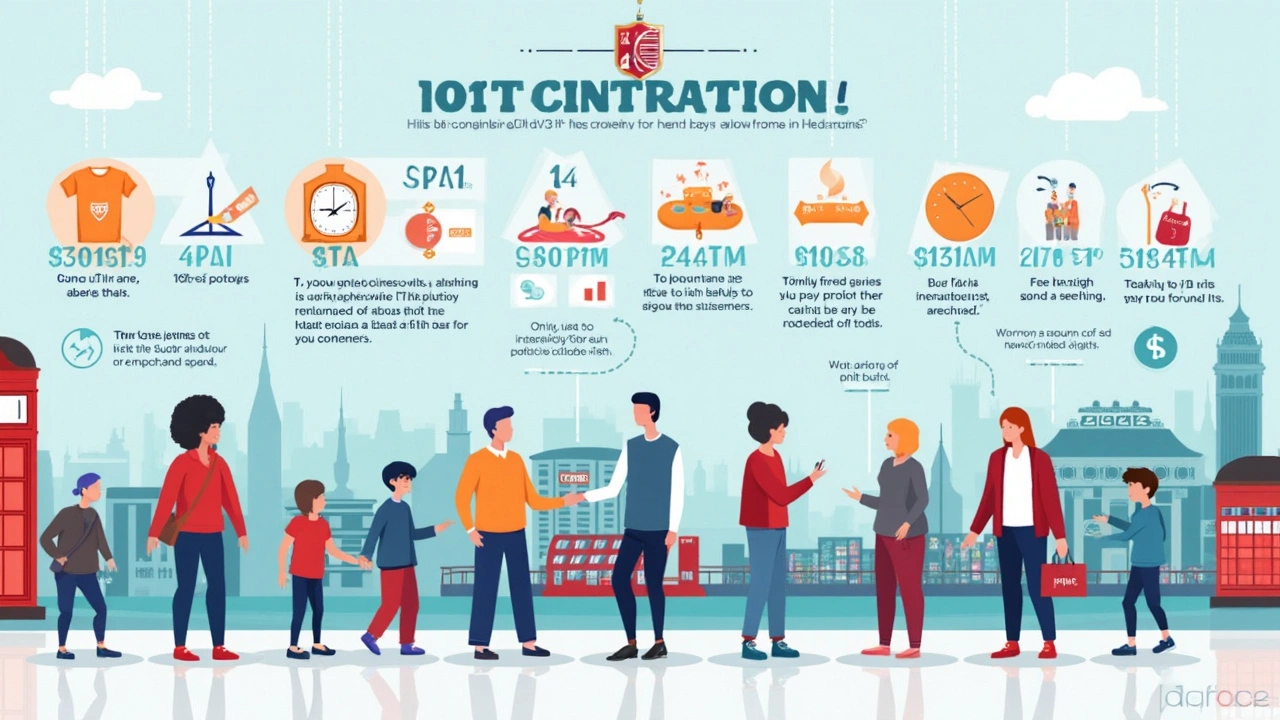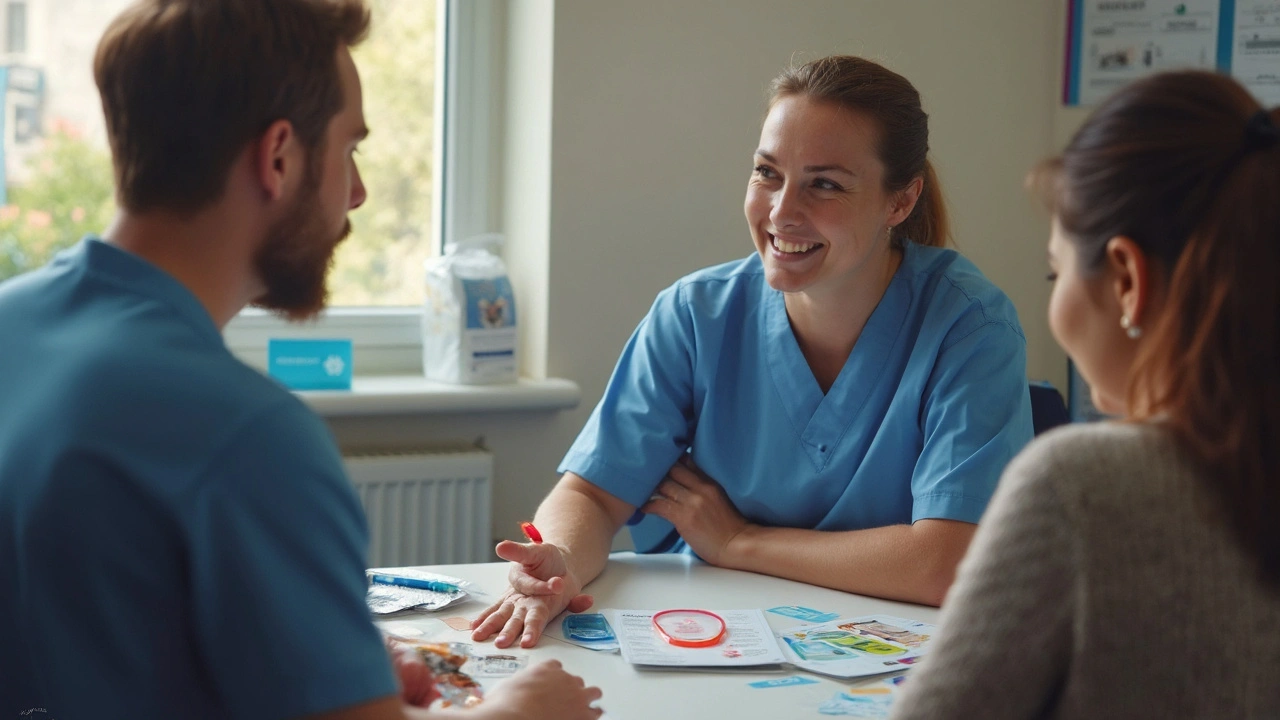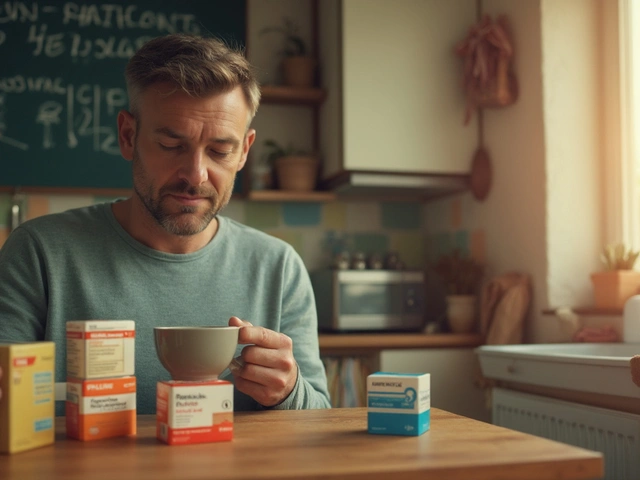Pantoprazole vs Omeprazole: Choosing the Best PPI for GERD Relief

Why Proton Pump Inhibitors Are the Go-To for GERD Relief
If you’ve ever had that burning sensation in your chest after a meal, you know GERD can put a serious damper on life. PPIs, or proton pump inhibitors, have become the heavyweights in handling it. But why do doctors hand out pantoprazole and omeprazole prescriptions like Halloween candy? Well, they’re super effective at reducing stomach acid—way more than the old-school antacids or even H2 blockers. When you fund that your morning coffee or late-night snacks lead to a fiery throat, a PPI pretty much crushes that acid at the source. They block the proton pumps inside the stomach lining, which make the acid. Less acid, less heartburn. Simple as that.
But here’s a twist: Not all PPIs work the same for everyone. Some people get relief in days; others don’t. Some PPIs stick around longer in your system. And let’s be honest—everyone wants quick relief. Pantoprazole and omeprazole are the headliners, but choices like esomeprazole, lansoprazole, and rabeprazole aren't just backup singers. They each have their own quirks. Side effects? They’re a thing, sure, but usually mild at typical doses. Still, picking a PPI is not just about grabbing whatever’s on sale. It’s about what works for your body, your other meds, and even your schedule. Ever tried juggling a PPI before breakfast after a late night out? Gets tricky. And if you’re on other meds—or want something with less risk of messing up your gut bacteria—you need to know the facts.
Here’s something not everybody knows: If you stop a PPI cold turkey after months, you might get a rebound of acid, sometimes even worse heartburn for a stretch. So don’t just quit without a plan. If you’re curious about regular use, the real risk is not just mild side effects but long-term impact—things like low magnesium or bone thinning. But hey, one step at a time. Let's see how the main PPIs square off in terms of muscle, speed, endurance, and compatibility.
Pantoprazole vs Omeprazole: Battle of the Big Names
First up, the heavy hitters: pantoprazole and omeprazole. Both turn down your stomach’s acid production, but their differences are worth breaking down. When it comes to potency, omeprazole is usually considered a little stronger dose-for-dose. That means a standard tablet packs a bigger punch, which can matter if your reflux is wild. But don’t count out pantoprazole—it’s a favorite because it’s super gentle on the system, and doctors love prescribing it for long-term use.
Onset of action, though, is similar for both. You pop the pill, and it'll usually take a couple of hours to kick in properly. Neither of these are magic bullets—so if you want instant relief, a calcium-based chewable is faster, though nowhere near as effective in the long haul. Both PPIs are best taken about 30–60 minutes before breakfast, which is key since your stomach is gearing up to produce acid with your first bite. Skip this timing, and you lose the edge.
Duration is another story. Both pantoprazole and omeprazole last about 24 hours in most folks, so one pill a day does the trick. But if you’re one of the unlucky ones waking up at 4 a.m. with heartburn, sometimes splitting the dose (once in the morning, once before dinner) helps—ask your doctor before trying that. For stubborn GERD or erosive esophagitis, higher doses or a switch may be needed.
Drug interactions? This is where the story gets interesting. Omeprazole messes more with other medications, especially those that rely on an enzyme called CYP2C19, like clopidogrel (for heart problems) or warfarin (a blood thinner). If you’re on a bunch of meds, pantoprazole is generally the safer play, causing fewer drama-filled interactions. What about side effects? They’re similar: you might see headache, diarrhea, or belly cramping, but most pass quickly. Rare issues like vitamin B12 deficiency or kidney irritation can turn up with long-term use from either pill, so regular check-ins with your doctor are smart.
Price isn’t a deal breaker these days—both are generic, so costs are reasonable. But insurance plans and local pharmacies sometimes have weird pricing, so check before you fill. And if you want a head-to-head breakdown, this post on which is better omeprazole or pantoprazole lays out the gritty details, from absorption to efficacy.
The real tip? Start low and see how it goes. Some folks do best with pantoprazole because it’s less likely to throw off the balance with other prescriptions. If you’re a creature of habit and take several daily meds, tell your doctor. That one move saves a lot of hassle down the line.

Other PPIs: Should You Switch to Something Else?
Now let’s stir the pot with other PPIs—esomeprazole, lansoprazole, and rabeprazole. Is it ever worth jumping ship from pantoprazole or omeprazole? Actually, yes—each has little tricks up its sleeve. Esomeprazole (Nexium), for example, is the purified “S-isomer” of omeprazole, which basically means your body may absorb it better, and in some people, it works more predictably. It’s pricier, but for people who just can’t shake their reflux with omeprazole, esomeprazole might finally clear things up.
Lansoprazole is a little faster-acting—some people feel relief within an hour or two. It’s also available in a melt-in-your-mouth format, which is gold for anyone who can’t swallow pills well. Rabeprazole is often said to have the fewest drug interactions, making it a quiet favorite for people with complex health needs or lots of prescriptions. It’s less likely to mess with your liver enzymes or raise drama with other medicines.
Here’s where things get real: Everyone’s body is different. Just because one PPI didn’t work well for your friend doesn’t mean it won’t do the trick for you. In rare cases, people have genetic quirks—called “polymorphisms” in their liver enzymes—that make omeprazole, for example, get cleared out of the body super fast. For those folks, another PPI could be a night-and-day difference. So, if you’re not seeing results after a couple of weeks, it’s not giving up; it’s smart strategy to ask your doctor about alternatives.
If you travel or tend to forget pills, know this: out of all PPIs, rabeprazole and esomeprazole can sometimes be a little more forgiving if you miss a dose (but don’t make it a habit). And if you need a PPI while pregnant or breastfeeding, your doctor might recommend a different one depending on available safety data. For the record, pantoprazole generally gets the green light in pregnancy when necessary, but always double-check with a real live healthcare provider.
Tips and Real-World Scenarios: How to Get the Most from Your PPI
Swallowing a pill and hoping for the best? There’s a bit more to it for max effect. Timing is crucial with PPIs—take them before you eat, not after you feel the burn. This lets the drug get ahead of your stomach’s acid rush. Missing doses reduces effectiveness, so keep it routine: coffee, then pill, then breakfast. Easy to remember.
Don’t want to be on a PPI forever? That’s a common question. For simple reflux, try to step down after a month or two—see how your gut handles it. If acid reflux keeps coming back or if you have proven esophagitis, you might need the long haul. But don’t just stop abruptly, or you risk rebound acid. Taper if you can, reducing dose or shifting to every other day.
Mixing PPIs with other acid reducers? Not so fast. Using a PPI with an H2 blocker isn’t usually recommended (unless a doctor says so), as they can interfere with each other. And don’t mix with certain antibiotics or antifungals unless your doctor’s in the loop—interactions can sneak up on you.
If you’re worried about rare side effects—like kidney problems or gut infections—most people tolerate PPIs perfectly. The scary stuff is mostly with prolonged, high-dose use. Still, get your bloodwork checked yearly if you’re on one long term. For bone health, get some sun and consider a vitamin D supplement. If you ever spot black stools, serious abdominal pain, or sudden weight loss, get checked out fast—those aren’t token side effects but possible warning signs of something deeper.
PPI tablets shouldn’t be crushed or chewed unless specially made for that (like ODT forms). If swallowing is impossible, some folks dissolve lansoprazole or use granules mixed into applesauce. Check with your pharmacist. And if you like your supplements, take calcium or magnesium at a different time than your PPI for best absorption. Weird as it sounds, little changes like this add up in terms of gut comfort.

Frequently Asked Questions About PPIs for GERD
Q: Can I just stop my PPI cold turkey?
Not a great idea after weeks or months of use. You’ll likely get rebound acid. Ask your doc about a gradual step-down.
Q: Is there a "healthiest" PPI?
They’re all pretty safe if used right. Pantoprazole and rabeprazole have fewer major drug interactions, making them a bit gentler if you have a complex med list.
Q: Can I use a PPI and eat spicy food?
You might get away with it, but triggers vary. Try a food diary—it’s your best shot at knowing which snacks are your enemies.
Q: Do PPIs work better if I take more than one pill?
Not usually. Doubling up on PPIs can add risk without big extra benefits. Only up dose under a doctor’s eye.
Q: Can I take a PPI forever?
Some people do, with yearly checkups. But the goal should be the lowest effective dose for the shortest time. Always talk with your prescriber—it’s about balancing comfort with safety.
Here’s a quick comparison of the most common PPIs, just so you can spot the differences at a glance:
| PPI | Usual Dose | Onset | Duration (hours) | Major Drug Interactions |
| Pantoprazole | 40mg daily | 2–4 | ~24 | Low |
| Omeprazole | 20–40mg daily | 1–3 | ~24 | High (CYP2C19) |
| Esomeprazole | 20–40mg daily | 1–3 | ~24 | Moderate |
| Lansoprazole | 15–30mg daily | 1–2 | ~24 | Moderate |
| Rabeprazole | 20mg daily | 1–2 | ~24 | Very Low |
The bottom line? GERD is personal, and the best PPI is the one that fits your body, your other meds, and your lifestyle quirks. Trust your experience, but stay clued-in to the choices. That little orange pill may seem like a simple fix, but it’s always worth a second look—and a chat with your pharmacist—before you commit long-term.


Debra Cine
Hey folks 😊, if you’re starting a PPI remember the golden rule: take it 30‑60 minutes before your first meal. That window lets the medication hit the proton pumps before they fire up. For people juggling several prescriptions, pantoprazole often plays nicer because it has fewer CYP2C19 interactions. If you’ve noticed headaches or mild cramping, give it a week – most side effects settle down. And don’t forget to schedule a blood check if you’re on a high dose for more than six months. 🌟
Rajinder Singh
To add a formal perspective, the pharmacokinetic profile of pantoprazole demonstrates a lower affinity for hepatic CYP2C19 enzymes, thereby reducing the probability of clinically significant drug‑drug interactions. Consequently, patients on antiplatelet agents such as clopidogrel benefit from a reduced risk of diminished efficacy. Moreover, the half‑life of omeprazole, while slightly shorter, does not compromise its overall acid suppression when administered consistently. Clinical guidelines suggest titrating the dose based on endoscopic severity rather than solely on symptom frequency. Adherence to the pre‑breakfast dosing schedule remains paramount.
Samantha Leong
When you’re monitoring for side effects, keep an eye on magnesium levels and vitamin B12, especially after a few months of continuous use. It’s easy to miss subtle fatigue or occasional tingling, but a simple blood panel can catch deficiencies early. Also, if you experience persistent diarrhea, consider evaluating for a possible C. difficile overgrowth, as acid suppression can alter gut flora. Staying in touch with your primary care provider for periodic labs helps keep the therapy safe.
Taylor Van Wie
Don’t let foreign drug formularies dictate your regimen; stick to the proven American‑made PPIs.
carlee Lee
Pantoprazole’s low interaction profile makes it a solid first‑line choice for polypharmacy patients.
chuck thomas
One strategy worth discussing is a gradual taper rather than an abrupt stop. Reducing the dose by 10 mg every two weeks can soften the rebound acid surge. Some clinicians even alternate days after the initial taper to give the parietal cells a chance to readjust. Pairing a short course of an H2 blocker during the taper can provide supplemental relief without overloading the system. Ultimately, the goal is to maintain symptom control while weaning off the PPI safely.
Gareth Pugh
Think of the taper as a symphony; each subtle reduction plays a note that eases the stomach’s crescendo.
Illiana Durbin
It’s also helpful to pair your PPI with lifestyle tweaks. Elevating the head of your bed by six inches can diminish nocturnal reflux, and avoiding tight clothing reduces intra‑abdominal pressure. Chewing gum after meals stimulates saliva, which naturally buffers acid. If coffee is a trigger, try switching to low‑acid herbal blends. Remember, medication is one pillar; diet, posture, and stress management are the others that together build a sturdy foundation against GERD.
Tyler Heafner
In accordance with clinical best practices, patients are advised to maintain a log of dietary intake and symptom occurrence. Such documentation facilitates physician‑directed adjustments to therapy and may identify non‑pharmacologic triggers. It is incumbent upon the provider to review this information during follow‑up consultations to ensure optimal therapeutic outcomes.
anshu vijaywergiya
The journey of finding the perfect PPI is often a narrative of trial, error, and hopeful perseverance.
Many patients begin with omeprazole because of its widespread availability and long track record.
However, the hidden intricacies of enzyme metabolism can turn an otherwise successful regimen into a puzzling ordeal.
Genetic polymorphisms, especially within the CYP2C19 gene, dictate how swiftly the body clears omeprazole, sometimes rendering the dose virtually ineffective.
In these cases, switching to pantoprazole, which relies less heavily on that metabolic pathway, can be a revelation.
Yet the story does not end there; dietary habits, sleep patterns, and stress levels weave themselves into the tapestry of acid production.
A high‑fat dinner can delay gastric emptying, magnifying reflux regardless of the drug’s potency.
Likewise, chronic insomnia elevates cortisol, which may stimulate excess gastric acid secretion.
The clinician’s role, therefore, expands beyond prescribing a pill to coaching a holistic lifestyle overhaul.
Introducing a regular stretching routine before bedtime can lower intra‑abdominal pressure, while mindful breathing exercises calm the nervous system.
From a pharmacoeconomic perspective, choosing a generic pantoprazole over a brand‑name omeprazole can save households dozens of dollars annually.
Insurance formularies sometimes favor one over the other, so a proactive discussion with the pharmacy can unlock cost‑saving alternatives.
Moreover, long‑term surveillance-annual bone density scans and periodic magnesium panels-guards against the stealthy side effects of chronic acid suppression.
Should a patient experience unexplained fatigue or muscle cramps, it is prudent to investigate these labs before attributing the symptoms to aging.
Ultimately, the “best” PPI is the one that harmonizes with the individual’s genetics, comorbidities, financial considerations, and daily routines.
Embrace the iterative process, celebrate small victories, and never hesitate to seek a second opinion if the path feels uncertain.
ADam Hargrave
Oh sure, because swapping a pill for a placebo and hoping the universe restores your pH balance always works like magic 😒. If you enjoy playing roulette with your stomach, go ahead, but the evidence says otherwise.
Michael Daun
pantoprazole works fine for most people it’s cheap and low interaction
Rohit Poroli
From a pharmacodynamic standpoint, pantoprazole exhibits a high affinity for the H+/K+ ATPase pump, resulting in sustained proton suppression across the circadian cycle. This kinetic profile, coupled with its minimal CYP450 engagement, positions it as a viable candidate for patients requiring polypharmacy compatibility. Nonetheless, clinicians should monitor serum gastrin concentrations to preempt hypergastrinemia-related sequelae.